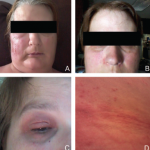Notable distinguishing features of FMF include a shorter duration of febrile episodes, usually lasting less than 72 hours, and lower extremity predilection for the rash. In contrast, Yao syndrome is characterized by predominantly facial and upper extremity rash, and the development of constipation, with some patients presenting with acute abdomen. Attempts to treat with colchicine can be revealing because patients with Yao syndrome don’t typically respond to, whereas it is the drug of choice for the treatment of patients with FMF.
The diagnosis of FMF was ruled out in our patient due to negative genetic testing for a mutation in the MEFV gene and lack of improvement with a prior trial with colchicine. Our choice of treatment with canakinumab was based on prior reports showing effective treatment with interleukin 1β neutralization.10 Other options include glucocorticoids, which can be given in pulses, and sulfasalazine, to which our patient was allergic.
Interestingly, there have been case reports of patients with concurrent mutations in both genes presenting as either an isolated Yao syndrome or an amalgamation between FMF and Yao syndrome.4 Although our patient had symptoms of only Yao syndrome, genetic testing in our patient revealed a mutation in both NOD2 and in the TNFRSF1A gene, associated with TRAPS.
Apart from the fever and abdominal pain present in both syndromes, TRAPS is associated with the development of localized myalgias, with overlying skin eruptions, pleurisy and periorbital edema, all of which were absent in our patient. Further, patients with TRAPS usually report a family history of the disease.5,11
The finding of more than one mutation associated with autoinflammatory disease in our patient raises questions about how these mutations interact with one another. Although clinically our patient fits most closely with the NOD2 mutation, there is uncertainty regarding the prognostic and management implications of the TNFRSF1A gene mutation in a patient with phenotypic Yao syndrome.
The pathogenesis of Yao syndrome remains elusive. NOD2 is a cytosolic innate immune sensor, working to maintain immune homeostasis as well as to monitor the environment for pathogenic material such as the peptidoglycan contained within the cell wall of bacteria. These features of NOD2 make it critical in the regulation of the immune mediated inflammatory response. Mutations in NOD2 have been implicated in Crohn’s disease, Blau syndrome, and most recently in Yao syndrome. The pathogenesis of Yao syndrome is considered to be multifactorial, dependent on the interplay between NOD2 function, other innate immune sensor mutations and the environment.5,12

